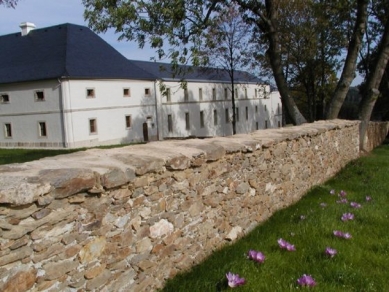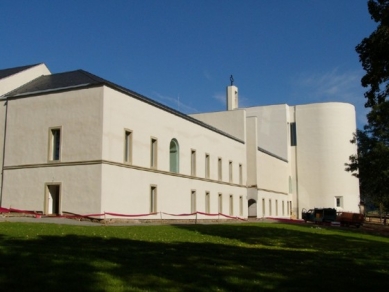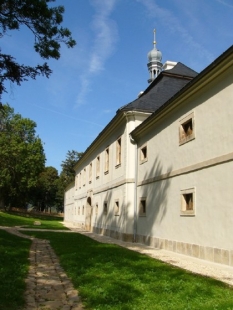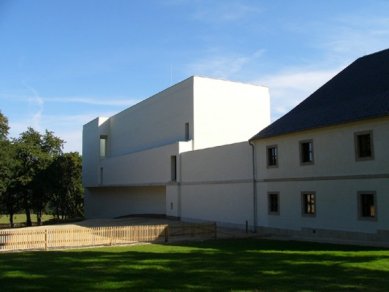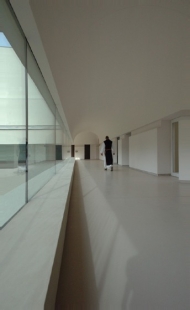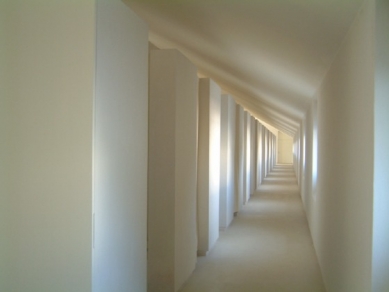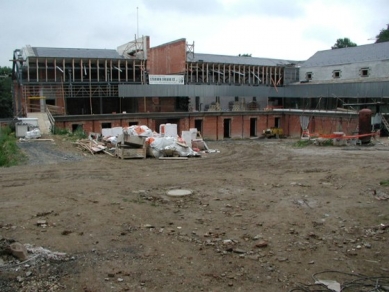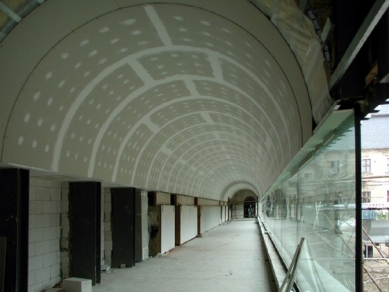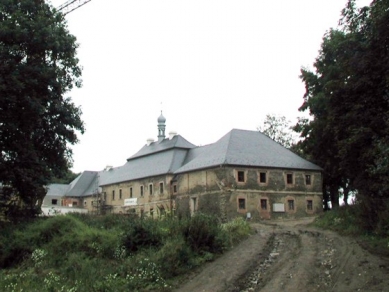
The Trappist Monastery Church in Nový Dvůr

Last year, when the Club for Old Prague Award was given to the multifunctional building Portheimka Center and four out of six nominated buildings were from Prague, this year's committee chose exclusively extra-Prague buildings, whose qualities were undoubtedly greater than last year's laureate. The reconstruction of a valuable baroque homestead by architect Kilián Ignác Dietzenhofer's circle by London-based minimalist John Pawson has been covered by the media since its inception and did not have to wait long for recognition. However, if Pawson's trend of building churches out of drywall is to start a new trend in this field, then God help us. The author should have stuck to boutiques of world-famous fashion brands where he has no competition, or at least changed the established range of materials to correspond with the spirit of the building.
At the last meeting, I stated one thing, and it still stands: this monastery is a unique opportunity in my career. I also said that the meeting with the monks was a tremendous enrichment for me, both creatively and spiritually. I could realize the significance of this enrichment even more intensely at the beginning of this year when I found myself in the beautiful and wild countryside near the city of Bombay. A serious accident occurred there, from which I emerged with only minor injuries, but my friend, who was sitting next to me, died on the spot... In the moment after the tragedy, as well as in the following days and weeks, I realized that although some unknown instinct was shutting my mouth, I sought comfort and understanding from my friends here in Nový Dvůr and in Sept-Fons. This experience reaffirmed for me that building a monastery is not just architecture, but that architecture here is meant to serve as a means.
Last year we gathered here to consecrate the foundation stone and thus began the construction of the three wings that we see today. We now embark on a new stage: we lay the same stone into the very foundations of the church, a building that more than any other represents life in Nový Dvůr. A year ago, work was being done here to repair the noble house. Today we see how modern architecture is taking shape. What until now were only ideas captured by imagination or stored in drawings now takes on three-dimensional forms. For the architect, these are strong and moving moments.
When I received this commission from the monks, I knew what I wanted to achieve in Nový Dvůr: to rediscover the ideal of Cistercian architecture of the 12th century, the time of Saint Bernard. To rediscover a sense of light, good proportions, simplicity, a sense of sober nobility, and details. I was convinced that the ancient ideal could be expressed in modern terms by precisely capturing its essence. In the architecture of Nový Dvůr, some elements may be new, but everything is connected by one aesthetic that fundamentally links to tradition. The cloister on consoles, for example, has no pattern in the history of Cistercian architecture, yet it remains true to the spirit of its 12th-century predecessor.
It is true that a place like Nový Dvůr has its own architectural history. One of the greatest tasks for me was therefore to decide which elements of the old architecture would be included in the new architecture. Certainly, the connection of old and new elements complicated the project and broke the expected architectural unity; nevertheless, I believe it becomes a symbol as eloquent as it is beautiful: a symbol of the connection between the past and the future, the engagement of religious life in the contemporary world.
The overall character of the architecture of Nový Dvůr was defined in a very short, yet intense time. It took much longer to refine the details that would help harmonize poetry with functionality. The goal is a complete harmony between the monastery and the community that inhabits it. Architecture that does not use joints and artificially grouped elements is not just an aesthetic mannerism. Rather, it seeks to remove sources of distraction, whether visual or functional, and to help the monks concentrate on God. Achieving this ideal required cooperation between my team in London, the architect Soukup's studio here in the Czech Republic, and the monks themselves. However, we all share one thing in common: high demands and a liking for details.
Le Corbusier, the architect who built the monastery at La Tourette, wrote: "The man who seeks harmony has a sense of the sacred." I could verify the truth of this statement during my work for the monastery in Nový Dvůr. I am deeply grateful to the monks for providing me with this unique opportunity. I am proud to have participated in the realization of their dream.
An interview with architect John Pawson about the project can be found here
More photos, including those from the course of realization: http://www.atelier-soukup.cz/
Petr Šmídek, April 8, 2005
At the last meeting, I stated one thing, and it still stands: this monastery is a unique opportunity in my career. I also said that the meeting with the monks was a tremendous enrichment for me, both creatively and spiritually. I could realize the significance of this enrichment even more intensely at the beginning of this year when I found myself in the beautiful and wild countryside near the city of Bombay. A serious accident occurred there, from which I emerged with only minor injuries, but my friend, who was sitting next to me, died on the spot... In the moment after the tragedy, as well as in the following days and weeks, I realized that although some unknown instinct was shutting my mouth, I sought comfort and understanding from my friends here in Nový Dvůr and in Sept-Fons. This experience reaffirmed for me that building a monastery is not just architecture, but that architecture here is meant to serve as a means.
Last year we gathered here to consecrate the foundation stone and thus began the construction of the three wings that we see today. We now embark on a new stage: we lay the same stone into the very foundations of the church, a building that more than any other represents life in Nový Dvůr. A year ago, work was being done here to repair the noble house. Today we see how modern architecture is taking shape. What until now were only ideas captured by imagination or stored in drawings now takes on three-dimensional forms. For the architect, these are strong and moving moments.
When I received this commission from the monks, I knew what I wanted to achieve in Nový Dvůr: to rediscover the ideal of Cistercian architecture of the 12th century, the time of Saint Bernard. To rediscover a sense of light, good proportions, simplicity, a sense of sober nobility, and details. I was convinced that the ancient ideal could be expressed in modern terms by precisely capturing its essence. In the architecture of Nový Dvůr, some elements may be new, but everything is connected by one aesthetic that fundamentally links to tradition. The cloister on consoles, for example, has no pattern in the history of Cistercian architecture, yet it remains true to the spirit of its 12th-century predecessor.
It is true that a place like Nový Dvůr has its own architectural history. One of the greatest tasks for me was therefore to decide which elements of the old architecture would be included in the new architecture. Certainly, the connection of old and new elements complicated the project and broke the expected architectural unity; nevertheless, I believe it becomes a symbol as eloquent as it is beautiful: a symbol of the connection between the past and the future, the engagement of religious life in the contemporary world.
The overall character of the architecture of Nový Dvůr was defined in a very short, yet intense time. It took much longer to refine the details that would help harmonize poetry with functionality. The goal is a complete harmony between the monastery and the community that inhabits it. Architecture that does not use joints and artificially grouped elements is not just an aesthetic mannerism. Rather, it seeks to remove sources of distraction, whether visual or functional, and to help the monks concentrate on God. Achieving this ideal required cooperation between my team in London, the architect Soukup's studio here in the Czech Republic, and the monks themselves. However, we all share one thing in common: high demands and a liking for details.
Le Corbusier, the architect who built the monastery at La Tourette, wrote: "The man who seeks harmony has a sense of the sacred." I could verify the truth of this statement during my work for the monastery in Nový Dvůr. I am deeply grateful to the monks for providing me with this unique opportunity. I am proud to have participated in the realization of their dream.
Speech by John Pawson at the laying of the
foundation stone of the Trappist monastery church in Nový Dvůr
foundation stone of the Trappist monastery church in Nový Dvůr
An interview with architect John Pawson about the project can be found here
More photos, including those from the course of realization: http://www.atelier-soukup.cz/
The English translation is powered by AI tool. Switch to Czech to view the original text source.
35 comments
add comment
Subject
Author
Date
Takový krásný statek to byl a býval ještě mohl být!
Martin Šíp
07.02.06 07:45
Velká slova pana architekta...
Martin Šíp
07.02.06 07:46
mš
07.02.06 08:19
tak teď si nejsem jistej...
tovyx
07.02.06 08:57
Ad sedlová střecha
Martin Šíp
07.02.06 09:26
show all comments





